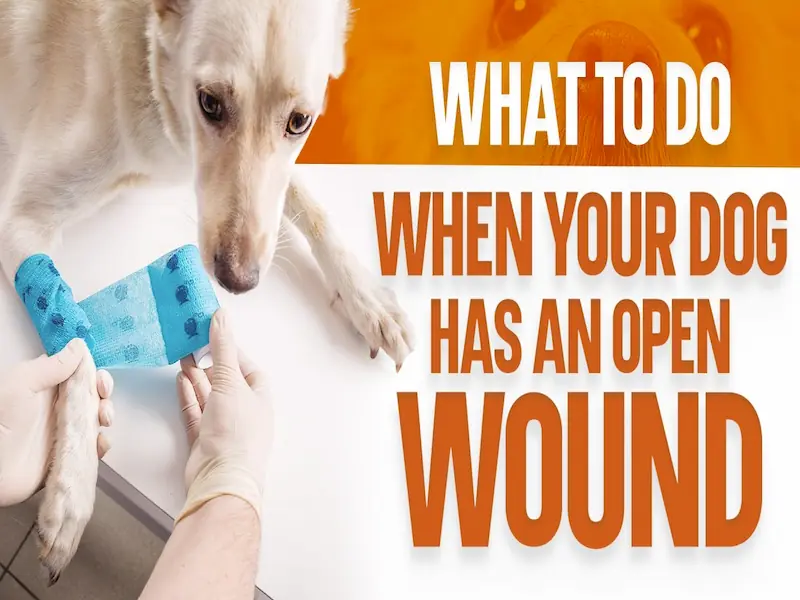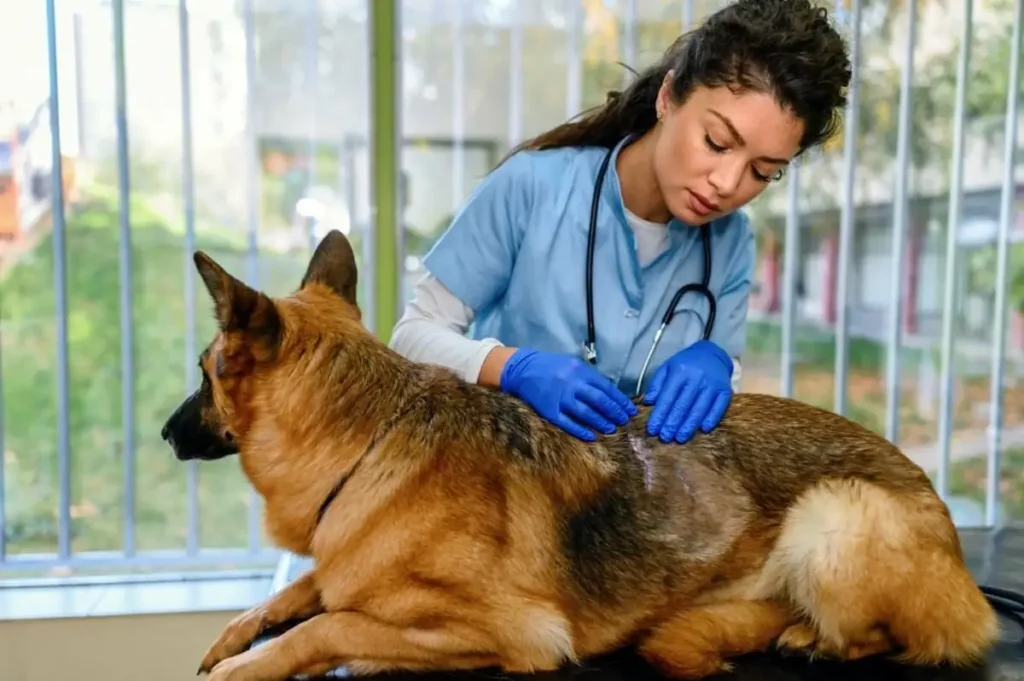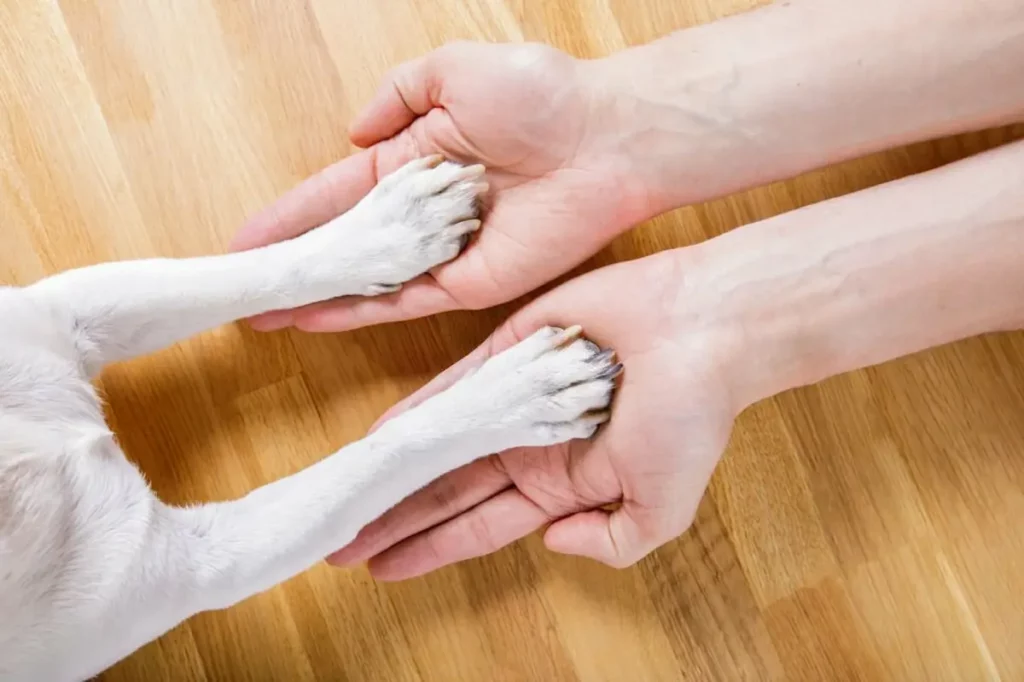My dog has an open wound. My vet suggested that it be left open for healing rather than repaired with sutures. What is the reason for this?
Wounds differ based on:
- Causes – puncture wounds scratches, or abrasions
- Location – paws, abdomen, eyes, etc.
- Infection level – Clean (surgical) wounds or wounds that are infected (infected)
Your vet has considered the above factors when determining the best method to treat the wound. Sometimes the site or extent of skin loss hinders surgery closure, or even bandaging (wounds in the facial area or at the knee). wound care is a slow process
Sometimes puncture wounds, or any other traumas force bacteria into tissues. A wound that is contaminated and longer than a couple of hours old should not close by surgery debridement (removal of all contaminated and dead tissues) and, in certain situations, it could cause more lasting injury than treating the wound with medical care and allowing it to heal.

What can I do to treat a wound on a dog?
Abscesses can be lanced or removed under intense sedation or anesthesia. A drain made of latex is installed to prevent the closure of the abscess too fast in order to permit adequate drainage and stop the growth of infection.
“Wherever possible a wound will be closed and sutured in order to speed healing.”
If it is possible, the wound is closed and then sutured to speed up healing. However, if there’s an infection or a deep laceration there is a need for the wound to be left open for treatment as well as for drainage.
Your vet might need to anesthetize your dog in order to eliminate dead cells from the area. If the wound is not shut surgically, the vet could apply a protective bandage in the event that this is feasible. Your dog will receive oral or injectable antibiotics (such as Amoxicillin Clavulanate or Cefazolin).
Related: WHAT IS PANNUS IN DOGS? HOW TO SPOT IT AND TREAT IT QUICKLY IN 2023
What do I need to do to take care of this wound on a dog?
After your pet has been discharged from the hospital, he or she has received specific instructions for caring for your pet at home. General pet care guidelines include:
- It is important to gently clean the wound and the surrounding area to remove any sticky or encrusted deposits. This helps keep the edges of the wound clear, reduces the risk of recurrence of the infection, and also allows the growth of healthy tissue.
- Take all medications according to your doctor’s instructions. Do not stop taking antibiotics for any reason unless your doctor has specifically told you to do so.
- Your dog should not chew or lick the wound. A lot of dogs require a collar to protect them (see the handout “Elizabethan Collars in Dogs” for more details) to stop injury to the site.
- It is crucial to stop it from healing the wound too fast. This is especially important for abscesses that have been lanced and removed surgically. If the wound does not close properly, the likelihood of recurrence increases.
How can I stop the wound will closing too soon?
After cleaning the wound, you can gently massage the skin to loosen the wound and facilitate drainage. There may be some bleeding or discharge as you perform this. Check if it appears to be affected (clear or colored drainage) or if it’s clear and thin. It is recommended to eliminate or allow any type of discharge to go away. If the discharge persists to be red, green, or yellow for a number of consecutive days, you should contact your vet to get instructions.
What should I use to clean the wound using?
Water from the tap is suggested to wash the majority of wounds. Warm salinity (salt solution) can also be utilized. This can be made by adding about one teaspoonful (5 milliliters) of salt (or Epsom salts) to two cups (500 milliliters) of drinking water. In some cases, your doctor may recommend applying a diluted chlorohexidine cleansing solution, surgical soap, or iodine solution to remove any residue.
Do not apply soaps, shampoos hydrogen peroxide, rubbing alcohol tea tree oil, or any other item to treat the wound unless instructed to use them by your doctor. Some of these Products may be toxic if consumed internally, while others may delay healing.
Related: PIROXICAM IN DOG: USES, SIDE EFFECTS, DOSAGES, PRECAUTIONS
Preventing injuries in dogs
While a Pet First Aid kit is essential for treating dog wounds, it’s also important to keep your dogs safe.
- Help your dogs jump from high platforms or vehicles
- Avoid slippery floors by applying structural sprays, rugs, or non-slip mats.
- Eliminate potential hazards at home such as sharp corners or broken glass.
- Keep dogs safe in a fenced yard and on a leash when outside.
Should I avoid using mild antiseptics?
Your physician might recommend antibiotics or creams for treating the wound. Because animals are known to chew and lick wounds, they may accidentally ingest medications or topically applied disinfectants or antiseptics that have been designed for human use and are not suitable for use in animals.
How should I handle my dog if he decides to clean the wound?
Many people are under the false assumption that saliva from dogs is some sort of antiseptic. It’s far from reality, particularly when you consider the manner in which dogs groom themselves or meet one another. A dog’s instinct is to bite a wound. However, this can cause significant delays in healing. This is why you should avoid this from happening by every means. Elizabethan collars have become the most widely employed protective device. Other options, depending on the wound site, include covering the wound with a bandage, a sock or dog coat, or even a T-shirt.
What are the alternatives to pain medication?
Your physician will prescribe medicines to alleviate discomfort and pain. When a wound begins to heal, it’s no longer painful. Your vet will evaluate the specific situation and decide the most suitable medication to treat your pet. The most commonly prescribed pain medications are non-steroidal anti-inflammatory medications (NSAIDs) like the meloxicam
Supplies Needed for Dog Wound Care
Be sure to be prepared with these materials:
- Electronic clippers (scissors or disposable razors are fine when handled properly)
- Water-based lubricant, similar to KY jelly (not Vaseline)
- Warm water
- Clothes that are clean (paper or fabric)
- Solution for an antiseptic (like 2 percent chlorhexidine)
- Ointment to combat antimicrobials
Let’s look at various types of dog wounds and how to care for them.
Types of Open Dog Wound
Abrasions
Abrasions are superficial wounds that involve abrasion of the skin. They can be caused by rough surfaces, like concrete or asphalt.
Lacerations
Lacerations are deep cuts or tears in the skin, often caused by sharp objects or trauma.
Puncture Wounds
Puncture wounds occur due to the penetration of sharp objects into the skin. Due to minimal external bleeding, they may not appear as serious as they are.
Burns
Burns can be caused by hot surfaces, chemicals, or friction, leading to tissue damage.
Surgical Wounds
Surgical wounds are incisions made during medical procedures, which require special care to prevent infection.
Hotspots
Hot spots in dogs (acute moist dermatitis) are inflamed, moist skin lesions that can occur anywhere on a dog’s body. These sores are painful, itchy, and often have an unpleasant odor due to the infection.
Hot spots are Dog wounds that result from violent scratching and biting on itchy skin (for example, if you have fleas).
Related: AMANTADINE FOR DOGS OUR GUIDE COMPLETE IN 2024
Recognizing and Assessing Wounds
Signs of an Open Wound
Recognizing an open wound is crucial. Signs include bleeding, swelling, redness, and visible damage to the skin or tissue.
The Importance of Timely Detection
Timely detection and evaluation of wounds will help provide immediate care and reduce the risk of complications.
First Aid for Dog Wounds
Safety First
Ensure both you and your dog are safe during the first aid process. Muzzle your dog if necessary.
Stopping Bleeding
Cleaning the Wound
Clean the wound with mild soap and warm water. Avoid using hydrogen peroxide as it can damage tissue.
Dressing the Wound
Properly dress the wound with a sterile bandage or non-stick pad and secure it with bandaging tape.
How to treat dog wounds at home
Now let’s move on to treating Dog Wound injuries, after having performed the first aid described above.
- Clean your dog’s wound regularly
To care for a dog’s wounds, the Dog Wound must be cleaned and re-treated every day. Use pet-safe antiseptic solutions to clean infected wounds. Otherwise, use clean water or saline solution.
- Cover the wound with a bandage
A dirty wound heals slowly and becomes infected, so it makes sense to cover the wound after cleaning.
Keep in mind that most sticky dressings are designed for human skin and do not adhere well to dogs. Ask a vet to show you how to safely apply a bandage to your dog’s wound to keep it clean.
- Get veterinary care if necessary
Schedule veterinary exams to ensure the wound heals properly. If necessary, antibiotics or other medications may be prescribed.
- Follow your vet’s instructions carefully
To provide proper care for a dog’s wound, be sure to give your pet the medications prescribed by your veterinarian in the right dosage and at the right time.
- Monitor your dog’s wound and general condition
Examine your dog’s wound daily and watch for any strange signs such as fever, chills, loss of appetite, oozing from the wound, or signs of pain.
Topical medications and treatments for dog wounds
For medications and topical treatments, be sure to only use those approved for use in animals. Here are some examples of medications often prescribed by a veterinarian to treat a cut or other open wound in your dog:
- Nonsteroidal anti-inflammatory drugs (NSAIDs) to relieve pain. Possible side effects include gastrointestinal upset, loose stools, and loss of appetite.
- To prevent infection, antibiotic ointments may be prescribed. Possible side effects include stomach upset, vomiting, diarrhea, and loss of appetite while taking the ointment.
- Oral antibiotic tablets help treat bacterial infections. Possible side effects include stomach upset such as diarrhea and nausea.
Professional Veterinary Care
When to Seek a Vet
Always consult your vet if the wound is deep, bleeding profusely, or shows signs of infection.
Treatment Options
Vet-recommended treatments may include stitches, antibiotics, or wound flushing.
Follow-up Care
Follow your veterinarian’s instructions for home wound care, including changing dressings and administering medications.
Preventing Dog Wounds
Supervision
Keep an eye on your dog to avoid accidents and intervene if necessary.
Safe Environment
Make sure your dog’s environment is free of hazards and potential sources of injury.
Protective Gear
Consider protective gear for your dog in situations where injuries are more likely.
Common Mistakes in Wound Care
Overlooking Small Wounds
Even small wounds can lead to complications if not treated promptly.
Using Inappropriate Substances
Avoid using substances like alcohol or peroxide that can harm tissue.
Delaying Veterinary Care
Seek professional care if you’re unsure about wound severity or if it shows signs of infection.
Veterinary Measures for Dog Wound
After an accident, the usual veterinary procedure is:
- First of all, stabilize the animal
- Next, treatment of a dog’s wounds is performed
- If the dog has open wounds, pressure is applied to stop the bleeding
- Next, it’s a matter of removing dirt and debris
Depending on the severity of the wound, it may be closed surgically or left open, but covered with a dressing. Your vet will recommend antiseptic solutions to clean your dog’s wounds and prescribe medications if necessary.
Home care is important. Therefore, give your dog all medications as directed and monitor him carefully. Make sure your dog does not bite, lick, or scratch the wound.
Conclusion
Caring for open dog wound is a vital skill for every pet owner. While minor wounds can often be managed at home, never hesitate to seek professional veterinary care when needed. Prompt and appropriate wound care can make a significant difference in your dog’s recovery and overall well-being.
how to heal a dog wound fast at home
natural antiseptic for dog wounds
dog wound care products
dog wound care spray
dog wound care near me
Dog Wound Care Reddit
dog wound care ointment
dog wound healing stages pictures
FAQs (Frequently Asked Questions)
What should I do if my dog’s wound becomes infected?
Consult your veterinarian for proper treatment, which may include antibiotics and wound care.
How can I keep my dog from licking the wound?
Consider using an Elizabethan collar (cone) to prevent licking, which can lead to infection.
Is there a way to prevent scars in my dog wound?
Proper wound care and following your vet’s instructions can help minimize scarring.
When can my dog return to regular activities after a wound?
Follow your vet’s guidance. It depends on the wound’s severity and the type of treatment received.



